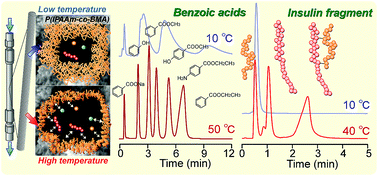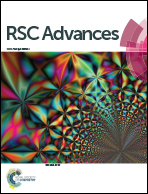Thermoresponsive hydrophobic copolymer brushes modified porous monolithic silica for high-resolution bioseparation†
Abstract
Thermoresponsive hydrophobic copolymer, poly(N-isopropylacrylamide-co-n-butyl methacrylate) [P(IPAAm-co-BMA)], brushes were prepared on porous monolithic silica rods through surface-initiated atom transfer radical polymerization (ATRP). The monolithic silica surface was modified with the ATRP-initiator [(chloromethyl)phenylethyl]trimethoxysilane (CPTMS) via silanization performed by flowing a CPTMS toluene solution into the monolithic silica rod column. ATRP was performed by flowing a reaction solution containing IPAAm and BMA monomers, and ATRP catalyst CuCl/CuCl2/tris[2-(N,N-dimethylamino)ethyl]amine in 2-propanol into the monolithic silica. Characterization by CHN elemental analysis, X-ray photoelectron spectroscopy (XPS), and gel permeation chromatography revealed that dense P(IPAAm-co-BMA) brushes were formed on the monolith surface. Chromatographic analysis using benzoic acids and insulin peptides indicated that the brush-modified monolithic silica was able to separate these analytes with high resolution and in short analysis times, owing to the effective interaction between the modified polymer brushes and the analyte. These results indicated that the present P(IPAAm-co-BMA) brush modified monolithic silica is an effective separation tool for analyzing bio-related molecules.


 Please wait while we load your content...
Please wait while we load your content...